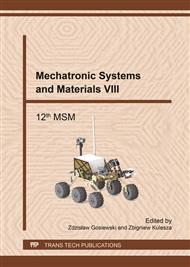[1]
M. Müller, B. Müller, S. Hensel, M. Nestler, S. F. Jahn, V. Wittstock, A. Schubert and W. -G. Drossel, Structural integration of PZT Fibers in deep drawn sheet metal for material-integrated sensing and actuation, Procedia Technology 15 (2014).
DOI: 10.1016/j.protcy.2014.09.027
Google Scholar
[2]
V. Gulizzi, P. Rizzo, A. Milazzo, E. La M. Ribolla, An integrated structural health monitoring system based on electromechanical impedance and guided ultrasonic waves, Journal of Civil Structural Health Monitoring Vol. 5 (2015) 337-352.
DOI: 10.1007/s13349-015-0112-0
Google Scholar
[3]
A. Koszewnik, The Active Vibration Control of the Smart Plate by using piezo-patches, Carpathian Control Conference (2015) 235-240.
DOI: 10.1109/carpathiancc.2015.7145080
Google Scholar
[4]
M. Okayasu, K. Sato and M. Mizuno, Influence of domain orientation on the mechanical properties of lead zirconate titanate piezoelectric ceramics, Journal of the European Ceramic Society 31 (2011) 141-150.
DOI: 10.1016/j.jeurceramsoc.2010.09.003
Google Scholar
[5]
O. Guillon,. F. Thiebaud and D. Perreux, Tensile fracture of soft and hard PZT, International Journal of Fracture 117 (2002) 235-246.
DOI: 10.1023/a:1022072500963
Google Scholar
[6]
M. Okayasu, S. Aoki and M. Mizuno, Effects of silver-based metal electroplate on fatigue properties of PZT ceramics, International Journal of Fatigue 30 (2008) 1115-1124.
DOI: 10.1016/j.ijfatigue.2007.08.002
Google Scholar
[7]
M. Okayasu, G. Ozeki and M. Mizuno, Fatigue failure characteristics of lead zirconate titanate piezoelectric ceramics, Journal of the European Ceramic Society 30 (2010) 713-725.
DOI: 10.1016/j.jeurceramsoc.2009.09.014
Google Scholar
[8]
A. Börger, P. Supancic and R. Danzer, The ball on three balls test for strength testing of brittle discs: stress distribution in the disc, Journal of the European Ceramic Society 22 (2002) 1425-1436.
DOI: 10.1016/s0955-2219(01)00458-7
Google Scholar
[9]
A. Börger, P. Supancic and R. Danzer, The ball on three balls test for strength testing of brittle discs: Part II: analysis of possible errors in the strength determination, Journal of the European Ceramic Society 24 (2004) 2917-2928.
DOI: 10.1016/j.jeurceramsoc.2003.10.035
Google Scholar
[10]
R. Danzer, W. Harrer, P. Supancic, T. Lube, Z. Wang and A. Börger, The ball on three balls test—Strength and failure analysis of different materials, Journal of the European Ceramic Society 27 (2007) 1481-1485.
DOI: 10.1016/j.jeurceramsoc.2006.05.034
Google Scholar
[11]
C. Barry Carter, M. Grant Norton, Ceramic Materials – Science and Engineering, Springer Science+Business Media, New York, (2007).
Google Scholar
[12]
Company Goodfellow, Material data for sputtering targets, call date 05. 04. 16: http: /www. goodfellow. com/pdf/3023_1111010. pdf.
Google Scholar
[13]
German Norm, DIN EN ISO 843-5, Hochleistungskeramik - Mechanische Eigenschaften monolithischer Keramik bei Raumtemperatur, Beuth, Berlin (2007).
DOI: 10.31030/9761019
Google Scholar


